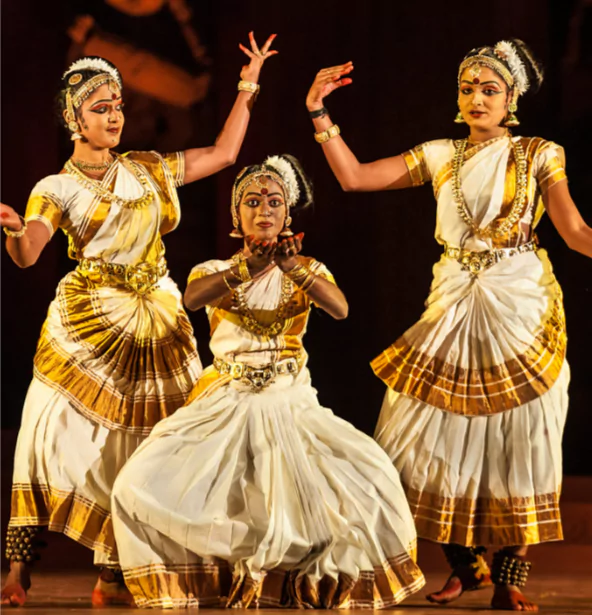Introduction
Mohiniyattam, a classical dance form from Kerala, is characterized by its fluid movements, graceful gestures, and expressive storytelling, often accompanied by Carnatic music and traditional attire.
About Mohiniyattam Dance Form
- Meaning: It is a classical solo dance form named after ‘Mohini,’ the celestial enchantress in Hindu mythology.
- It symbolizes the element of air.
- Origin: The dance’s origin is associated with a Puranic story, where Lord Vishnu assumed the form of Mohini to seduce Asuras during the churning of the ocean and the slaying of Bhasmasura.
- Historical References: Vyavaharamala (by Mazhamagalam Narayanan Namputiri) and Ghoshayatra (by poet Kunjan Nambiar).
- Current Form: Maharaja Kartika Tirunal and Maharaja Swati Tirunal of Travancore (18th-19th century AD) structured the dance into its present-day classical format.
- The Nangiars, women from the Nambiar community, still preserve this tradition by performing within temple precincts.
Enroll now for UPSC Online Course
Features of Mohiniyattam

- It combines the grace and elegance of Bharatnatyam with the vigour of Kathakali.
- It is characterized by graceful, delicate body movements without abrupt jerks or leaps and subtle facial expressions.
- It belongs to the lasya style, emphasizing femininity, tenderness, and grace.
- Footwork is rendered softly and without thumping.
- Emphasis is placed on hand gestures and Mukhabhinaya, involving subtle facial expressions.
- Gestures are borrowed from texts like Hastalakshana Deepika, Natya Shastra, Abhinaya Darpana, and Balarambharatam.
- Closeness to Natural and Realistic Expressions: Gestures and facial expressions are more aligned with natural (gramya) and realistic (lokadharmi) styles, as opposed to dramatic or rigidly conventional (natyadharmi).
- Costume: White and off-white saree with gold-coloured brocade designs.
- There is no elaborate facial make-up, and the dancer wears a leather strap with bells (Ghungroo) on her ankles.
- ‘Atavakul or Atavus’: collection of forty basic dance movements
- Musical Instruments: Cymbals, veena, drums, flute, etc.
- Famous proponents: Sunanda Nair, Kalamandalam Kshemavathy, Madhuri Amma, Jayaprabha Menon etc.
Enroll now for UPSC Online Classes
Conclusion
- Mohiniyattam exemplifies the beauty and elegance of Kerala’s cultural heritage, captivating audiences with its mesmerizing choreography, emotive storytelling, and enduring legacy in Indian classical dance.
![]() April 12, 2024
April 12, 2024
![]() 1600
1600
![]() 0
0
